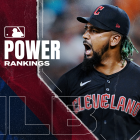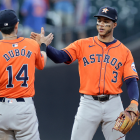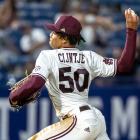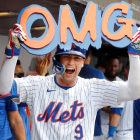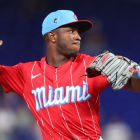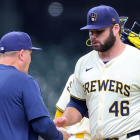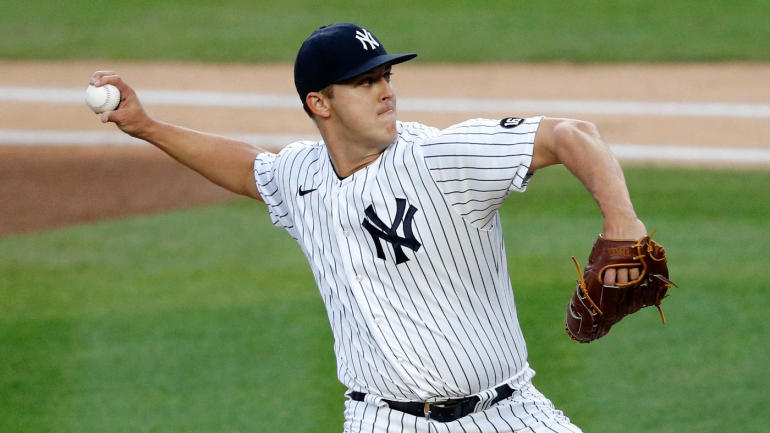
Eight weeks into the new season the New York Yankees are 28-19 with a plus-24 run differential. They started 5-10 but have since gone 23-9, the American League's best record during that time. New York just swept the first place White Sox, and will begin a three-game series with the AL East rival Blue Jays on Tuesday.
Two weeks ago we looked at Luke Voit's return, Giancarlo Stanton's hot streak, and what the Yankees see in Wandy Peralta. Here are three new notable Yankees trends.
Much improved defense in May
Early on, the team defense was a major deficiency for the Yankees. Seemingly every game they'd make one (or often more) defensive misplays that contributed to extra runs or even just extra pitches for the guy on the mound. The defense was their undoing far too often and a primary contributor to their 5-10 start.
Not coincidentally, the defense has been much improved during the team's 23-9 stretch. To really accentuate the improved defense, the Yankees turned a triple play Friday night and six double plays in the final two games of this past weekend's White Sox series. Here are the numbers (MLB ranks in parenthesis):
| Games | Defensive efficiency | Outs above average | Batting average on ground balls | |
|---|---|---|---|---|
April | 26 | .726 (12th) | -10 (28th) | .245 (25th) |
May | 21 | .746 (3rd) | +11 (1st) | .186 (2nd) |
Defensive efficiency is the percent of batted balls turned into outs, so the Yankees have gone from 72.6 percent in April to 74.6 percent in May, which may not seems like much, but is enough to go from middle of the pack to near the top of the league. Outs above average is a Statcast creation that measures, well, how many outs a defense converts relative to the league average.
The batting average allowed on ground balls is telling. The league average is .228. The Yankees were well above that in April and they're well below it in May. There are obvious sample size caveats here but the numbers do not lie. The Yankees are turning significantly more ground balls into outs now than they were last month, and the numbers match the eye test.
"It was a luxury to turn all the double plays," Gerrit Cole said after the Yankees turned four double plays behind him Saturday (video link). "We played our tails off on defense today. That was fun. Fun to be a part of. We pitched ourselves into a few ground balls for sure, we tried to force a couple double plays, and it worked out for us. That's exciting."
Gleyber Torres had a brutal opening week at shortstop, but has since played the position so well that he rates as an above average defender according to Defensive Runs Saved (plus-2) and Ultimate Zone Rating (plus-1.4). Personnel changes have helped too. Luke Voit's return has pushed DJ LeMahieu back to second base, which has improved the defense at two positions.
The truth likely lies somewhere in the middle. The Yankees aren't truly as good defensively as they've been in May nor are they truly as bad as they were in April. The performance this month has happened though, and it's helped them win a lot of games. Thanks to the improved defense, the Yankees went into Monday's off-day allowing only 3.51 runs per game, second fewest in MLB.
Taillon's one great pitch
When the Yankees open their series with the Blue Jays on Tuesday night, they'll do so riding a 35-inning scoreless streak from their starting pitchers. They recently received four straight starts of at least seven scoreless innings for the first time since 1932, and they already have nearly as many starts with six scoreless innings this year (11) as the last two years combined (15).
Jameson Taillon, despite throwing five scoreless innings against the White Sox on Sunday, has been the weak link in New York's rotation this year. He owns a 5.06 ERA in nine starts and 42 2/3 innings this season, his first since his second career Tommy John surgery. Home runs have been a real problem (1.9 HR/9), though 50 strikeouts and only 12 walks is a fine ratio.
With the Pirates, Taillon was a two-seam fastball pitcher who pounded the bottom of the zone. The Yankees have had him embrace elevated four-seam fastballs and a more north-south approach (similar to Cole and Tyler Glasnow after they left Pittsburgh), and the early returns are encouraging. Taillon has one of the best fastball swing-and-miss rates in MLB (min. 300 four-seamers thrown):
- Jacob deGrom, Mets: 36.1 percent
- Lance Lynn, White Sox: 34.1 percent
- Max Scherzer, Nationals: 33.2 percent
- Jameson Taillon, Yankees: 32.1 percent
- Freddy Peralta, Brewers: 32.1 percent
(MLB average: 23.2 percent)
"He's quite a bit different pitcher than he's been in the past when he's been very successful," manager Aaron Boone recently told reporters, including Sarah Valenzuela of the New York Daily News, about Taillon reinventing himself as a four-seam fastball pitcher. "I do feel like he's only going to continue to get better and I think game experience will hopefully help in that."
As good as Taillon's fastball has been this year, his secondary pitches have lagged, and at times he's become a predictable one-pitch pitcher. Here are the numbers on Taillon's curveball, long his go-to second pitch (2018 was his last full and healthy season before his second Tommy John surgery):
| Batting average | Slugging percentage | Swing and miss rate | |
|---|---|---|---|
2018 | .203 | .313 | 37.8% |
2021 | .306 | .361 | 24.1% |
MLB averages | .206 | .323 | 33.1% |
Taillon's velocity has been gradually ticking up since spring training and the Yankees are hopeful he'll sharpen his curveball as he builds up innings and gets further away from elbow reconstruction. The 5.06 ERA is objectively bad, though there are enough encouraging signs to stick with Taillon every fifth day, starting with his elite four-seam fastball.
"The velocity's getting a little better and the stamina's getting a little better, so I'm encouraged with it," Taillon told reporters, including Greg Joyce of the New York Post, following Sunday's start.
Waiting on Florial
So far, 2021 is the year of the no-hitter, and it's also the year of the injury. The Athletic's Ken Rosenthal recently noted non-COVID injured list stints are up 15 percent from this time in 2019, and soft tissue injuries have nearly doubled. Perhaps the unusual start-stop nature of the 2020 season is to blame. Perhaps it's something else entirely. Whatever it is, injuries are up.
The Yankees have been unable to escape the injury bug the last few weeks. Giancarlo Stanton is expected to return this week from his quad strain, though New York recently lost center field Aaron Hicks to what is likely to be season-ending wrist surgery. This is the club's center field depth chart at the moment:
- Aaron Hicks (likely out for season with wrist surgery)
- Brett Gardner
- Greg Allen (on Triple-A injured list with oblique strain)
- Ryan LaMarre (on injured list with hamstring strain)
- Tyler Wade (a natural infielder)
LaMarre was called up to replace Hicks last week because Allen was hurt, then landed on the injured list himself with a hamstring strain that is expected to sideline him a while. Wade has some outfield experience but not much, yet the Yankees have leaned on him as their fourth outfield the last few days. He made a nice catch in right field to preserve Corey Kluber's no-hitter last week.
Gardner has taken over as the starting center fielder since Hicks went down, but at age 37, less is more at this point in his career. The Yankees are reportedly discussing a Delino DeShields Jr. trade with the Rangers, though that hasn't come together yet, so Wade is the backup center fielder by default. Either that, or the Yankees will have to move Clint Frazier or Aaron Judge to center.
"I don't know what could happen outside the organization, but inside, we can call someone up if we get in a pinch, and I feel comfortable putting Tyler Wade out there or sliding Clint Frazier over in a pinch," Boone told reporters, including CBS Sports, over the weekend. "I don't think I'd do that with Aaron Judge right now, but we'll see. We can't run Gardy out there nine innings every day and run him into the ground."
One player the Yankees are not inclined to use in center field right now: Estevan Florial. He is arguably the best defensive outfielder in the organization, and he is on the 40-man roster, so calling Florial up would be a piece of cake. That the Yankees promoted him from Double-A to Triple-A in the middle of a series two weeks ago tells us they're willing to call Florial up if necessary.
"That's a balance you've got to strike," Boone told reporters, including CBS Sports, when asked about calling Florial up vs. keeping him in Triple-A. "You never want to bring anyone up here that isn't at least somewhat ready to take on that challenge, especially when you're talking about a player with Flo's potential."
Our R.J. Anderson listed Florial as a Yankees prospect to know before the season, saying he has "star-level ceiling" but is unlikely to reach it given injury and swing-and-miss issues. The Yankees did bring him up for one game last season, during which Florial went 1 for 3 with two strikeouts. He is 5 for 29 (.172) with two homers in seven Triple-A games this year.
There are two reasons to keep Florial in Triple-A. One, his pitch recognition needs work and remains his fatal flaw as a prospect. He is a disciplined hitter, Florial knows a ball from a strike, but he struggles discerning a fastball from a breaking ball from a changeup. Asking a young hitter to improve his pitch recognition at the MLB level is asking for trouble.
And two, Florial simply needs to play and make up for at-bats lost to injury and the pandemic. Separate wrist injuries limited him to 149 games and 675 plate appearances in High Class-A from 2018-19, then he spent last year at the alternate site. Florial needs to play and get back into the grind of day in, day out baseball, and continue his development.
Summoning Florial now would essentially be jumping a young hitter with pitch recognition deficiencies from High Class-A to MLB, and does that sound like a recipe for success? No, no it does not. Florial can play defense at the MLB level right now, and he can put a mistake in the seats, but he's not at a point now where he's ready to consistently contribute at the big league level.
The Hicks injury does not make Florial more MLB ready. He is no more MLB ready now than he was three weeks ago, when the minor league season began. Rather than put him in an impossible situation, the Yankees will stick with their other internal center field candidates (Gardner, Wade, etc.) or go outside the organization (DeShields) for help. They don't see Florial as not the answer right now. They're not willing to risk damaging his long-term development.
"It's important that he's playing," Boone said over the weekend. "But sometimes you have a need that can somewhat trump that. He's certainly in play and we're very comfortable with him as far as from a coaching staff standpoint. We've been with him a lot. We know him well. So, we'll cross that bridge if if we have to at some point, but it's a balance that you have to strike and those are conversations you always have. But nothing is imminent there anyway."












